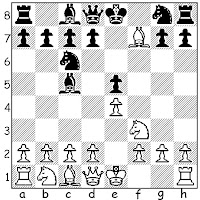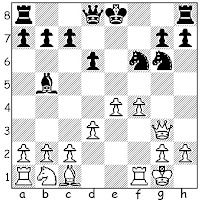Well, that was quick.
As mentioned in the last post, my Jerome Gambit game against vz721 in the Chess.com Italian Game Thematic Tournament (see "Started"), was staggering towards and unhappy ending, and has now ended with a "knockout" - a 29-move loss.
I have a little time, while defending an Evans Gambit against MarkHundleby1 (with the same moves as in my other game, with Black, against vz721), to repair my favorite opening.
Do I suspect that MarkHundleby1 will allow me to play 1.e4 e5 2.Nf3 Nc6 3.Bc4 Bc5 4.Bxf7+? It's a good bet. He is obviously aware of the play of the games around him in the tournament. Why wouldn't he want to wander down easy street and follow vz721's lead?
1.e4 e5 2.Nf3 Nc6 3.Bc4 Bc5 4.Bxf7+ ...and related lines
(risky/nonrisky lines, tactics & psychology for fast, exciting play)
Friday, August 2, 2013
Wednesday, July 31, 2013
Tourney Update
Play has been pretty fast and furious for me in the Chess.com Italian Game Thematic Tournament (see "Started").
I have drawn both my games against top-rated JoseSoza, the two completed games so far.
However, vz721, one sharp player (second-rated in our quad), improved on some of Alonzo Wheeler Jerome's original analysis (!) and has been treating my one Jerome Gambit rather harshly. I am currently hanging in there, but the phrase "punch drunk" comes to mind...
With Black against MarkHundleby1, I am defending well against his Evans Gambit. When that is complete, I will have my last chance at a Jerome Gambit - and therein lies an interesting tale for a later date.
Monday, July 29, 2013
Endgame Battle
Bill Wall passes along another Jerome Gambit endgame. I merely touched upon this battle 3 years ago in "A Working Class, Impatient Move" - it is time to give it a closer look.
Wall,B - Firewine
Chess.com, 2010
1.e4 e5 2.Nf3 Nc6 3.Bc4 Bc5 4.Bxf7+
4...Kxf7 5.Nxe5+ Nxe5 6.Qh5+ Kf8
7.Qxe5 Bd6
As I wrote in "The Gentleman or the Tireder?" two and a half years ago, "This move is better than it looks at first glance, and forces White's Queen to abandon the center or abandon the board."
8.Qa5
This was new at the time, although Bill played it later in Wall,B - Guest2591977, PlayChess.com, 2012 (1-0, 22).
8...Qf6
Guest2591977 continued with 8...Ne7.
9.Nc3 Ne7 10.d3 h6 11.0-0 b6 12.Qa4 c6
13.Be3 Bc5
It is not clear that opposing White's Bishop in this way is helpful, for as long as Black's King and Queen are on the same file, initiating and exchange is out of the question.
14.e5 Qg6 15.Ne4 d6 16.Nxd6
Bill now prefers 16.exd6 Bxd6 17.Bxb6.
16...Bh3
Threatening 17...Qxg2 mate, but this is readily met.
17.Qe4 Qxe4 18.dxe4 Be6 19.Bxc5 bxc5
Here we have an interesting Jerome Gambit endgame. White, still with all his original pawns, has compensation for his sacrificed piece. In fact, with his Rook on the same file as Black's King, he has a bit of initiative.
20.f4 Nc8 21.f5 Bd7
Bill points out that the Bishop belongs on the other diagonal, as in 21...Bf7 22.e6? Nxd6 23.exf7 Nxe4 24.Rae1 Nf6 25.Re5 Kxf7 26.Rxc5 Rac8 when Black is looking a bit better (at least White's pawns are not a dynamic threat).
22.Nb7 Ke7
Giving up a pawn. It might not have seemed as important as activating his pieces.
23.Nxc5
23...Rf8
This loses the bishop.
24.f6+ gxf6 25.exf6+ Rxf6 26.Rxf6 Kxf6 27.Nxd7+
White is now 3 pawns up.
27...Ke6 28.Nc5+ Ke5 29.Re1 Nd6 30.Nd3+ Kd4
Or 30...Ke6 31.e5 Nf5 32.g4 Nd4 33.Rf1 Nxc2 34.Rf6+ Kd5 35.Rxh6
31.e5 Ne4 32.e6 Re8 33.e7
Better, notes Bill, is 33.Nf4 Ke5 34.g3
33...Rxe7 34.Nf2 Re5 35.Nxe4
As planned, but Bill points out that better was 35.c3+! Kd5 36.c4+ Kd4 37.Rd1+ Kxc4 38.b3+ Kc3 39.Rd3+ Kb2 40.Re3 Kxa2 41.Nxe4
35...Rxe4 36.Rxe4+ Kxe4 37.Kf2 Kd4
Black should go for opposition of kings, but White has the extra tempo to win.
38.g4 c5 39.Kf3 Ke5 40.h4 a5
Better was 40...a6. Black's problem is that his King can't cover both sides of the board.
41.a4 c4 42.c3 Kf6 43.Ke4 Ke6 44.Kd4 Kf6 45.Kxc4 Ke5 46.b4 axb4 47.cxb4 Kf4 48.b5 Kxg4 49.a5 Kxh4 50.a6 Black resigned
Saturday, July 27, 2013
Spicy!
It is said that "variety is the spice of life."
While a defender may know that Bill Wall is going to play the Jerome Gambit, 1.e4 e5 2.Nf3 Nc6 3.Bc4 Bc5 4.Bxf7+, he certainly will not know what variation Bill is going to spring upon him.
Wall,B - Guest2360621
PlayChess.com, 2013
1.e4 e5 2.Nf3 Nc6 3.Bc4 Bc5 4.Bxf7+
4...Kxf7 5.Nxe5+ Nxe5 6.Qh5+ Ng6
7.Qd5+ Ke8 8.Qxc5 d6 9.Qa3
This is the 6th different Queen move that Bill has played in this position. As he notes, " I try to make a new move every time when I can, to see what happens. The Queen can probably go anywhere as long as it is not taken or trapped."
Previously,
9.Qe3 - Wall,B - Parsom, Chess.com, 2010 (1-0, 25); Wall,B - HeHe, Chess.com, 2010 (1-0, 19); Wall,B - Reza,A, Chess.com, 2011 (1-0, 43); Wall,B - G3LC, PlayChess.com, 2011 (1-0, 22); Wall,B - Guest3312852, PlayChess.com, 2012 (1-0, 26);
9.Qh5 - Wall,B - Guest1475978, Sofia, 2013 (1-0, 28);
9.Qb5+ - Wall,B - Zhu,Y, Chess.com, 2011 (1-0, 19); Wall,B - Guest327668, PlayChess.com, 2012 (1-0, 22);
9.Qc4 - Wall,B - Royercordova, Chess.com, 2010 (1-0,18);
9.Qc3 - Wall,B - NFTM, FICS, 2010 (1-0, 22); Wall,B - Jaar,J, Chess.com, 2010 (1-0, 19).
For the record, Houdini 3, given 10 minutes "thought" for "infinite analysis", prefers 9.Qe3 (-.92), followed by 9.Qc3 (-1.17) and 9.Qb5+ (-1.29).
9...Nf6
The current game is the only one in The Database with this line. Bill suggests as an alternative 9...Qh4.
10.0-0 Be6
Not 10...Nxe4? because of 11.Qa4+.
11.f4 Bf7 12.f5 Ne5 13.d4 Nc6 14.d5
Bill suggests as well the alternative 14.Qd3
14...Ne5
15.Re1 Qd7 16.Bf4 Nc4 17.Qc3 b5 18.b3 Nb6 19.e5 dxe5 20.Bxe5
Threatening 21.Bxf6+, winning the knight. Now Black could keep things in balance with 20...Nxd5, but the threatened discovered check is too uncomfortable.
20...Kd8 21.Bxf6+ Kc8 22.Bxg7
A little stronger might be Bill's suggestion 22.Re7
22...Rg8 23.f6
Threatening Re7
23...Nxd5 24.Qd4 Qd6 25.c4 bxc4 26.bxc4 Nb6
A bit better was 26...Nb4, threatening ...Nc2, winning the Rook, although White is still better after 27.Qxd6 cxd6 28.Nc3.
27.Qxd6 cxd6 28.Re7
28...Bxc4 29.f7 Bxf7 30.Rxf7 Nd7
The advanced "Jerome pawn" has cost Black a piece.
31.a4 Kc7 32.a5 Kc6 33.Na3 Nc5 34.Nc2 Rab8 35.Nd4+ Kd5
Black threatens 36...Rxg7 37.Rxg7 Kxd4
36.Nf5 Ne4 37.Rxa7
Threatening Ne7+, forking King and Rook, but Black had enough here and resigned.
Labels:
Chess.com,
G3LC,
guest,
HeHe,
Houdini,
Jaar,
Jerome Gambit,
Parsom,
Playchess,
Reza,
Royercordova,
Wall,
Zhu
Thursday, July 25, 2013
Started!
The fourth and final round of the Chess.com Italian Game thematic tournament has started, and there are four competitors: JoseSoza of Chile, vz721 of Russia, MarkHundleby1 of Canada, and yours truly, perrypawnpusher of the USA.
This presented as many as three more opportunities to defend the "honor" of the Jerome Gambit 1.e4 e5 2.Nf3 Nc6 3.Bc4 Bc5 4.Bxf7+, depending on how my opponents wished to defend.
So far, JoseSoza has declined the Jerome with 3...Be7, choosing the Hungarian Defense. This is his second "pass" after scoring two wins against my Gambit in rounds one and two.
On the other hand, vz721 has allowed it with 3...Bc5, and I was quick to sacrifice the Bishop! Let us hope this is not another example of Act in haste, Repent at leisure.
I have Black against MarkHundleby1 right now (defending against the Evans Gambit; alas, not the Evans Jerome Gambit), so the chance for a Jerome Gambit has to wait - unless he plays it against me!
The results, as for previous rounds, come what may, will be reported.
graphic by Jeff Bucchino, the Wizard of Draws
Tuesday, July 23, 2013
Jerome Gambit - Over the Board??
In a comment to the previous post on this blog, Quckturtle asked if I played the Jerome Gambit (1.e4 e5 2.Nf3 Nc6 3.Bc4 Bc5 4.Bxf7+) in over-the-board games.
I responded in the negative, mostly because I rarely play face-to-face games these days; instead, I play blitz and turn-based games on the internet.
Indeed, Eric Schiller, in his 2002 Gambit Chess Openings, referred to the Jerome Gambit as a "cyberspace gambit".
Yet, I wonder along with Quickturtle: who plays the Jerome Gambit in over-the-board play these days?
I have known for years that Jerome Gambit Gemeinde member Pete Banks ("blackburne") from Great Britain used to play it regularly - but, who else?
If you know someone, or if you play the Jerome otb yourself, please drop me a quick note (richardfkennedy@hotmail.com) or add a comment to this post, and let us know.
Sunday, July 21, 2013
Tossed Back And Forth
Here is the second kind of Jerome Gambit game that I encounter, where my opponent and I toss the game back and forth, and there are plenty of chances for me to take the advantage and run.
Sometimes, like in the following game, I do so.
perrypawnpusher - charlyeliot
blitz, FICS, 2013
1.e4 e5 2.Nf3 Nc6 3.Bc4 Bc5 4.Bxf7+
4...Kxf7 5.Nxe5+ Nxe5 6.Qh5+ Ng6 7.Qd5+ Ke8 8.Qxc5 d6 9.Qe3 Nf6
A familiar position - I've been here over 40 times, scoring over 80%.
10.0-0 Bd7 11.f4
Standard pawn play for me, but perhaps 11.d4 was a bit better.
11...Bb5
Or 11...Qe7 as in perrypawnpusher - peroneal, blitz, FICS, 2009 (½-½, 56).
12.d3 Ng4 13.Qg3 Nf6
The Knight returns home. From a different perspective, 13...Qh4, looking to exchange Queens, was playable. (Curiously, an almost identical position after 13...Qh4 occurred in Wall, B. - Guest3312852, Playchess.com, 2012 [1-0, 26], only Black's Bishop was on c4 and White's Knight was on c3.)
14.Nc3 Qd7
I occasionally use Houdini 3 to help me understand what is going on. Using "blunder check" set at 5 minutes per move, the program boiled the game down to the basics: 14...Bc6 15.f5 Nf8 16.d4 h5 17.Re1 Kf7 18.Bg5 Kg8 19.e5 dxe5 20.dxe5 h4 21.Qf4 Nd5 22.Qd2 Qd7 23.e6 Qd6 24.Nxd5 Qxd5 25.Qxd5 Bxd5 26.e7 Bc6 27.exf8Q+ Rxf8 28.Re5 Rh5 29.f6 gxf6 30.Bxf6 where White has a small, but perhaps not decisive edge.
Who knew?
15.f5
This move is okay, but I missed 15.e5 dxe5 16.fxe5 Nd5 17.e6!? which sets up the tactical shot 17...Qc6 18.Nxd5 Qxd5 19.c4 winning a piece.
15...Ne5 16.d4
This exchange sacrifice is not good.
16...Nh5
Trying to complicate things, when 16...Bxf1 17.dxe5 dxe5 18.Qxe5+ Kf7 19.Kxf1 Rhe8 20.Qf4 Qe7 would leave Black with an edge.
17.Qg5 Bxf1 18.Qxh5+
This allows Black's other Knight to escape directly, whereas Houdini 3's choice was: 18.dxe5 g6 19.e6 Qg7 20.Kxf1 c6 21.Kg1 h6 22.Qg4 Nf6 23.Qf3 Rg8 24.h3 Rd8 25.Ne2 gxf5 26.exf5 Ke7 27.g4 Nd5 28.c4 Nb4 with advantage to White.
18...Nf7 19.Kxf1 Qc6
The smoke is clearing, and White has two pawns for the exchange.
20.Be3 Qa6+ 21.Kg1 Qc6 22.e5 dxe5 23.dxe5 g6 24.fxg6
Stronger was 24.Qh3 gxf5 25.Rf1.
24...Qxg6 25.Qxg6
Exchanging favors. Black should have captured on g6 with the pawn, and White had a much better choice in 25.Qe2!?
25...hxg6 26.Bd4 Rh6 27.Nd5
There is still a fight going on. Black should now protect his c-pawn with his Rook, as his choice of moves allows another tactical shot (which I missed).
27...Kd7 28.Rd1
Instead, 28.e6+!? wins material.
28...Kc6 29.Nb4+ Kb5 30.Nd3 a6
More slipping and sliding.
31.Nf2
Missing a chance to show some cooperation among my pieces, winning material: 31.a4+ Kxa4 (31...Kc6 32.e6 Kd5 33.Nf4+ Ke4 34.exf7 Kxf4 35.Bc3 Rh7 36.Rf1+ Ke4 37.f8Q Rxf8 38.Rxf8 ) 32.b3+ Kb5 33.c4+ Kc6 34.e6 Nd8 35.Nb4+ Kd6 36.Bg7+ Kxe6 37.Bxh6.
31...Rd8 32.h3
And the game is about even.
32...Kc4 33.Bc3 Re8
Exchanging Rooks was the right idea. Now Black gives back the exchange, and White starts pushing things.
34.Ng4 Rh5 35.Nf6 Rd8 36.Rxd8 Nxd8 37.Nxh5 gxh5
38.Kf2 Ne6 39.Kg3 b5 40.Bd2 Kd5 41.Bf4 Nxf4 42.Kxf4 c5 43.g4 hxg4 44.hxg4 c4 45.g5 b4 46.g6 c3 47.b3 Ke6 48.g7 Kf7 49.Kf5 Kxg7
50.Ke6 Kf8 51.Kd7 a5 52.e6 Kg7 53.e7 Kf7 54.e8Q+ Kg7 55.Ke7 Kh7 56.Qf8 Kg6 57.Qf6+ Kh7 58.Qg5 Kh8 59.Kf7 a4 60.Qh6 checkmate
Subscribe to:
Posts (Atom)






































